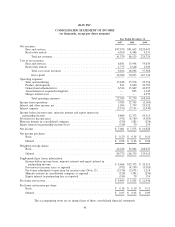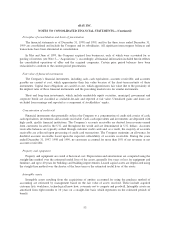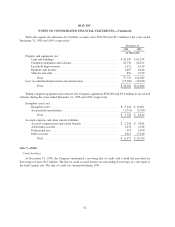eBay 1999 Annual Report Download - page 60
Download and view the complete annual report
Please find page 60 of the 1999 eBay annual report below. You can navigate through the pages in the report by either clicking on the pages listed below, or by using the keyword search tool below to find specific information within the annual report.various corporations. Sponsorship fee revenues are recognized over the term of the sponsorship agreement.
Advertising revenues and auctioneer tuition fees do not represent a significant source of revenues and are
recognized as advertising and auctioneer training services are provided.
B&B auction revenues are derived primarily from auction commissions and fees from the sale of property
through the auction process. Revenues from these sources are recognized at the date the related auction is
concluded. Service revenues are derived from financial, appraisal and other related services and are recognized
as such services are rendered. Rental revenues are derived from property rentals to third parties.
To date, advertising revenue, which includes barter advertising, has accounted for less than 1% of the
Company’s revenue. Historically, the Company has recorded barter revenue only to the extent that specific
objective evidence existed demonstrating the fair value of benefits given and received. As a result, most barter
transactions were judged to have no value or associated revenue.
Product development costs
Product development costs include expenses incurred by the Company to maintain, monitor and manage the
Company’s website. The Company recognizes website development costs in accordance with Statement of
Position (‘‘SOP’’) 98-1, ‘‘Accounting for the Costs of Computer Software Developed or Obtained for Internal
Use.’’ As such, the Company expenses all costs incurred that relate to the planning and post implementation
phases of development. Costs incurred in the development phase are capitalized and recognized over the
product’s estimated useful life if the product is expected to have a useful life beyond one year. Costs associated
with repair or maintenance of the existing site or the development of website content are included in product
development expense in the accompanying consolidated statement of income.
Advertising expense
The Company recognizes advertising expenses in accordance with SOP 93-7 ‘‘Reporting on Advertising
Costs.’’ As such, the Company expenses the costs of producing advertisements at the time production occurs,
and expenses the cost of communicating advertising in the period in which the advertising space or airtime is
used. Internet advertising expenses are recognized based on the terms of the individual agreements, but generally
over the greater of the ratio of the number of impressions delivered over the total number of contracted
impressions, or a straight-line basis over the term of the contract. Advertising expenses totaled $2.8 million,
$15.4 million, and $45.3 million during the years ended December 31, 1997, 1998 and 1999, respectively.
Stock-based compensation
The Company accounts for stock-based employee compensation arrangements in accordance with
provisions of Accounting Principles Board (‘‘APB’’) Opinion No. 25, ‘‘Accounting for Stock Issued to
Employees,’’ and complies with the disclosure provisions of SFAS No. 123, ‘‘Accounting for Stock-Based
Compensation.’’ Under APB No. 25, compensation expense is based on the difference, if any, on the date of the
grant, between the fair value of the Company’s stock and the exercise price. The Company accounts for stock
issued to non-employees in accordance with the provisions of SFAS No. 123 and the Emerging Issues Task Force
(‘‘EITF’’) Consensus on Issue No. 96-18.
Income taxes
Income taxes are accounted for using an asset and liability approach which requires the recognition of taxes
payable or refundable for the current year and deferred tax liabilities and assets for the future tax consequences
eBAY INC.
NOTES TO CONSOLIDATED FINANCIAL STATEMENTS—(Continued)
55
























